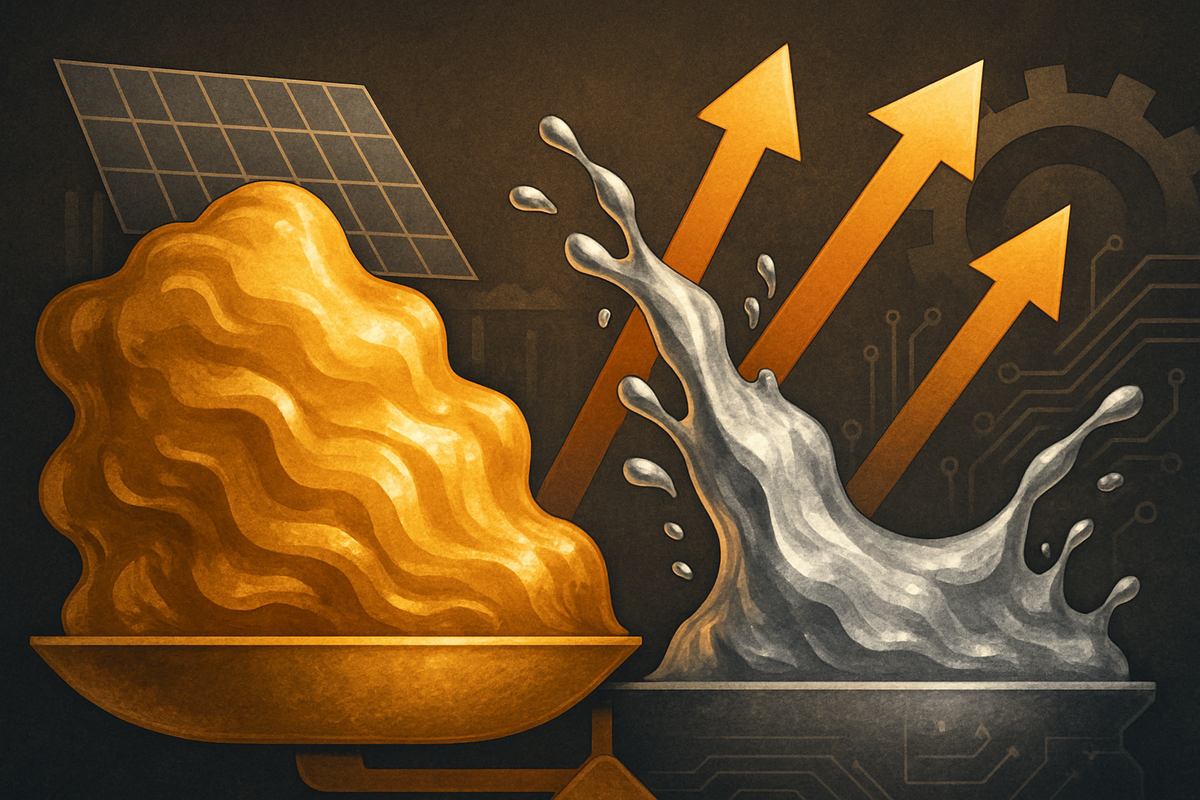
As of October 3, 2025, the financial markets are witnessing a compelling shift in the perennial dance between gold and silver, with the latter staging a remarkable rally that is profoundly impacting the venerable gold/silver ratio. This key indicator, which reflects the number of silver ounces required to purchase one ounce of gold, has tightened significantly, signaling a period of robust outperformance for silver and prompting investors to re-evaluate their precious metal strategies.
Silver, often overshadowed by its yellow counterpart, has quietly surged by over 60% year-to-date, with prices now hovering between $47 and $47.96 per ounce. This impressive ascent has pushed the gold/silver ratio from approximately 85 in early September to a more constrained range of 81 to 83.42, a clear testament to silver's growing strength. The implications are multifaceted, suggesting not only a potential rebalancing in the precious metals complex but also highlighting silver's dual role as both a safe-haven asset and a critical industrial commodity.
The White Metal's Ascent: A Confluence of Catalysts
Silver's dramatic rally throughout 2025 is not an isolated event but rather the culmination of several powerful economic and market forces. Starting the year at around $29.60 per ounce, silver has consistently climbed, maintaining its best price levels in over a decade and posting its seventh consecutive weekly advance. This robust performance has been fueled by a synergistic combination of monetary policy adjustments, escalating industrial demand, geopolitical uncertainties, and burgeoning speculative interest.
A pivotal moment arrived in September 2025 with a 25 basis point rate cut by the US Federal Reserve, a move widely anticipated to be followed by another reduction in October. Such dovish monetary policy decisions tend to weaken the dollar, thereby enhancing the appeal of non-yielding assets like silver and gold by reducing their opportunity cost. Simultaneously, the global industrial landscape is experiencing an explosion in demand for silver. Approximately 60% of global silver consumption is industrial, driven by rapidly expanding sectors such as solar panels, electronics, and electric vehicles. With China's economy showing signs of recovery, industrial demand is soaring, leading to expectations that consumption will outstrip supply for the fifth consecutive year in 2025. This persistent supply deficit is a significant bullish factor for silver prices.
Beyond industrial and monetary influences, geopolitical instability and domestic political gridlock, including a recent government shutdown in Washington, have amplified safe-haven demand for precious metals. Investors, seeking refuge from uncertainty, have increasingly turned to both gold and silver. Furthermore, speculative interest has surged, with broad market speculation and rising net long positions in silver, as evidenced by Commitment of Traders (COT) data, indicating a strong belief in further price appreciation. The narrowing of the gold/silver ratio from 85 to the current 81-83.42 range is a direct consequence of silver's outperformance, with experts predicting a potential drop towards 75 in the coming months, further emphasizing silver's relative strength. This dual utility as both an investment and an industrial metal provides silver with unique drivers for growth, particularly in an environment of robust industrial expansion.
Corporate Fortunes Shifting: Miners, Refiners, and Streamers Poised for Impact
The surging silver prices and the subsequent narrowing of the gold/silver ratio are creating a distinct bifurcation of fortunes within the precious metals sector, significantly benefiting companies with substantial exposure to the white metal. From primary miners to refiners and streaming companies, the landscape is ripe with opportunities for those positioned to capitalize on silver's ascendancy.
Silver mining companies stand as direct beneficiaries of this rally. Higher silver prices translate immediately into enhanced revenue and profitability, bolstering their margins on mined output and potentially leading to stronger earnings and increased shareholder returns. Companies with significant silver reserves, such as First Majestic Silver Corp. (NYSE: AG), which derives a majority of its revenue from silver, and Pan American Silver Corp. (NASDAQ: PAAS), a major silver-focused miner across the Americas, are poised for substantial gains. Similarly, Fresnillo plc (LSE: FRES), one of the world's largest primary silver producers, is expected to see a considerable boost to its financial performance. Other notable silver miners like Hecla Mining Company (NYSE: HL), Coeur Mining, Inc. (NYSE: CDE), and Endeavour Silver Corporation (NYSE: EXK) are also well-positioned, often acting as "gold with leverage" due to silver's tendency for larger percentage moves.
While primarily gold-focused, many major gold mining companies also produce silver as a significant byproduct, thus enjoying a secondary benefit from silver's rally. Giants like Newmont (NYSE: NEM), Barrick Gold (NYSE: GOLD), and Agnico Eagle Mines (NYSE: AEM) will see their overall revenues and profitability increase, with silver contributing an additional upside to their already strong gold performance. However, a potential caveat for diversified miners is that if prices of other primary metals (like copper, lead, or zinc, from which 70-80% of global silver is produced as a byproduct) were to decline, it could constrain silver supply despite high silver prices, impacting their overall output strategy. Precious metals streaming and royalty companies, such as Wheaton Precious Metals Corp. (NYSE: WPM) and Franco-Nevada (NYSE: FNV), are also direct beneficiaries. These companies provide upfront financing to miners in exchange for future metal production at fixed prices or a percentage of revenue, allowing them to benefit from rising metal prices without the operational risks of mining. Wheaton, with approximately 39% of its revenue from silver, is particularly well-positioned. Refining companies, including Mexico-based Industrias Peñoles (OTC: IPOAF) and UK-based StoneX Metals Ltd., will also experience increased activity and profitability as higher prices and potentially increased mining output drive demand for their processing services. The narrowing gold/silver ratio, in particular, highlights silver's outperformance, making companies with higher silver exposure especially attractive and suggesting continued robust gains for the white metal.
Beyond the Immediate: Wider Significance and Broader Trends
The current dynamics of the gold/silver ratio, driven by silver's impressive rally, are not merely isolated market phenomena but rather integral components of broader, evolving trends within the global precious metals industry. This shift carries profound implications, influencing various stakeholders, potentially reshaping regulatory landscapes, and echoing historical patterns of market behavior.
The precious metals market as a whole is experiencing robust growth, fueled by persistent global geopolitical tensions—including ongoing conflicts and trade disputes—and concerns about financial stability. These factors consistently drive investors towards gold and silver as traditional safe-haven assets. Furthermore, anticipated interest rate cuts by central banks, particularly the U.S. Federal Reserve, are making non-yielding assets more attractive by reducing the opportunity cost of holding them. With U.S. inflation hovering at 2.4% year-over-year as of September 2024, precious metals are also gaining traction as hedges against inflation and currency devaluation. A crucial trend is the continued aggressive purchasing of gold by central banks, with a significant majority planning to increase their holdings, providing a robust long-term demand floor. For silver, its dual role as both a precious and industrial metal is a key driver. It is experiencing surging demand from rapidly expanding green technologies such as solar panels, electric vehicles (EVs), and 5G infrastructure, creating a persistent global supply shortfall that is expected to continue as industrial consumption outstrips mine production.
The ripple effects of a sustained silver rally are far-reaching. Silver mining and exploration companies, as direct beneficiaries, will see increased revenue and profitability, likely leading to expanded exploration budgets and production plans. This benefits major players like Fresnillo plc (LSE: FRES), Pan American Silver Corp. (NASDAQ: PAAS), and First Majestic Silver Corp. (NYSE: AG). Industries reliant on silver as a key industrial input—such as manufacturers of solar panels, electronics, and electric vehicles—will face increased input costs but are expected to maintain strong demand due to silver's critical role in high-growth sectors. This could also spur innovation in silver recycling and the development of alternative materials. In financial markets, precious metals Exchange Traded Funds (ETFs) like iShares Silver Trust (NYSE Arca: SLV) and SPDR Gold Shares (NYSE Arca: GLD) could see increased inflows as investors seek exposure to this dynamic market.
Regulatory and policy implications are also coming into sharper focus. Significantly, the U.S. Geological Survey's 2025 draft list proposes classifying silver as a critical mineral. If finalized, this designation would elevate silver from a precious hedge to a strategic industrial asset, potentially unlocking government stockpiling, permitting support, and tax incentives. This policy support, combined with existing supply deficits and accelerating industrial demand, could create unprecedented investment dynamics for silver, with global implications as allied nations consider similar initiatives. Additionally, evolving Environmental, Social, and Governance (ESG) requirements are impacting mining operations globally, potentially increasing production costs but also highlighting the value of projects in stable jurisdictions. Meanwhile, the Reserve Bank of India (RBI) has implemented new regulations for gold and silver collateralized loans, effective October 1, 2025, which prohibit loans for purchasing gold and introduce stricter repayment terms and transparency rules for pledged metals.
Historically, the gold/silver ratio has exhibited a strong tendency for mean reversion and distinct behavior during different economic cycles. While the long-term average ratio is generally cited under 60 (and around 58-60 over the last 50 years), it can spike significantly during economic uncertainty as investors flock to gold. Conversely, during periods of economic growth and optimism, the ratio tends to decline as silver, with its industrial demand, often outperforms gold. Crucially, during strong precious metals bull markets, the gold/silver ratio historically contracts, as silver tends to amplify gold's price movements, rising even more dramatically. The current elevated ratio, despite silver's recent surge, suggests that silver may still be undervalued relative to gold, aligning with historical patterns that imply further potential for silver outperformance as the broader precious metals bull market matures.
What Comes Next: Navigating the Precious Metals Landscape
As silver continues its impressive rally and the gold/silver ratio tightens, the precious metals market stands at a pivotal juncture, presenting both compelling opportunities and strategic challenges for investors and companies alike. The trajectory for both gold and silver appears overwhelmingly bullish in the short and long term, driven by a confluence of macroeconomic forces and shifting demand dynamics.
In the short-term, spanning late 2025 into 2026, gold is widely anticipated to stabilize between $3,800 and $4,000 per ounce, with some forecasts even reaching $4,200. This upward momentum is underpinned by strong central bank demand and the ongoing easing of monetary policy by the US Federal Reserve. Silver, currently trading around $42-$48 per ounce, is expected to continue its ascent, potentially hitting $48-$55 by the end of 2025 and even $70 by the end of 2026, with some analysts predicting it will test its all-time high of $49 soon. The gold/silver ratio is projected to further narrow, possibly dropping towards 75, underscoring silver's continued relative strength. Looking further out to 2030 and beyond, the long-term outlook for gold remains firmly bullish, with predictions ranging from $5,000 to an ambitious $7,000 per ounce, fueled by persistent inflation, geopolitical tensions, and ongoing central bank accumulation. Silver's long-term prospects are equally bright, with forecasts of $80-$100 per ounce or even higher by 2030, driven by insatiable industrial demand from green technologies and persistent supply deficits.
For investors, strategic adaptations are crucial. Diversification remains key, with analysts often recommending at least a 10% allocation to gold and silver, potentially with a 60/40 split favoring gold for stability and silver for growth. Given the bullish long-term outlook, a strategy of accumulating on dips and maintaining long-term holdings is advisable. Increasing exposure to silver is particularly strategic, given its potential for outsized gains and its strong industrial demand profile. Investors should consider silver-backed funds or mining companies for exposure, alongside gold-backed funds or miners. Vigilant monitoring of inflation, Federal Reserve interest rate policies, the U.S. dollar's performance, and global geopolitical developments will be paramount, as these factors are primary drivers for precious metals. Companies in the mining and refining sectors must prioritize operational efficiency, embrace technological innovation like AI and satellite monitoring, and demonstrate strong Environmental, Social, and Governance (ESG) leadership to attract investment and navigate regulatory complexities. Addressing the persistent supply deficits, especially for silver, through sustainable production increases and new mine development, will also be critical, though the long lead times for new projects present a significant challenge.
Emerging markets present both significant opportunities and challenges. Central banks in these regions, particularly China, are aggressively expanding their gold reserves as part of de-dollarization strategies, providing a robust demand floor. Simultaneously, emerging markets are driving substantial industrial demand for silver in green energy applications and electronics. However, geopolitical risks, potential regulatory changes in producing nations, and currency volatility in local markets can create headwinds. Overall, the prevailing sentiment for the precious metals market is overwhelmingly bullish. A "bullish scenario" sees persistent inflation, aggressive Fed rate cuts, escalating geopolitical tensions, and surging industrial demand for silver pushing prices significantly higher, potentially leading to gold at $5,000/oz long-term and silver reaching new all-time highs. A "neutral/moderate growth scenario" would see steady, moderate appreciation with controlled inflation and gradual rate adjustments. While a "bearish scenario" involving a stronger dollar, rapid disinflation, or resolution of major conflicts is less likely in the current outlook, it remains a possibility to consider. The gold/silver ratio is expected to continue its decline, signaling silver's stronger relative performance in the foreseeable future.
The Silver Lining: A Market Poised for Transformation
The current dynamics of the gold/silver ratio mark a significant inflection point in the precious metals market, with silver's robust rally serving as a potent indicator of shifting investment paradigms and evolving industrial demands. The white metal's impressive outperformance against gold, narrowing the historical ratio, is a testament to its dual appeal as both a safe-haven asset in uncertain times and a critical industrial commodity essential for the burgeoning green technology sector.
Key takeaways from this market movement include the profound impact of dovish monetary policies, which reduce the opportunity cost of holding non-yielding assets, and the relentless surge in industrial demand for silver, particularly from solar panels, electric vehicles, and electronics. This demand, coupled with persistent supply deficits, creates a powerful upward force on silver prices. The U.S. Geological Survey's proposed classification of silver as a critical mineral further underscores its strategic importance, potentially paving the way for government support and incentives. Companies with significant silver exposure, from primary miners like First Majestic Silver Corp. (NYSE: AG) to streaming companies like Wheaton Precious Metals Corp. (NYSE: WPM), are well-positioned to capitalize on this trend.
Moving forward, investors should closely monitor the trajectory of interest rates, inflation figures, and geopolitical developments, as these will continue to exert considerable influence on both gold and silver. The gold/silver ratio itself will be a crucial barometer; a continued narrowing suggests further outperformance for silver and a potential rebalancing of the precious metals complex. While gold remains a foundational hedge, silver's unique combination of investment and industrial drivers positions it for potentially more dynamic growth. The market is poised for continued transformation, and those who understand and adapt to silver's ascendant role are likely to find significant opportunities in the months and years to come.
This content is intended for informational purposes only and is not financial advice





